Sales Enablement simply means enabling measurable increases in sales effectiveness. This also means providing sales professionals with the tools and techniques to generate a more productive engagement with buyers, supported by timely coaching and mentoring interventions.
Let's think about increasing sales effectiveness in the high-value, high-touch sell. This is a focus on sales and business development professionals who work inside a diverse range of knowledge-intensive tech, manufacturing and services firms: aerospace & defence; automotive manufacturers; accounting practices; business process outsourcers; communications service providers; digital agencies; IT system integrators; law firms; management consultants, and so forth. For these firms, and these sales professionals, what truly increases sales effectiveness?
In the remainder of this blog post, I have divided this topic into three areas: Design Thinking Applied; Sales Technology Applied; and, Sales Learning Applied.
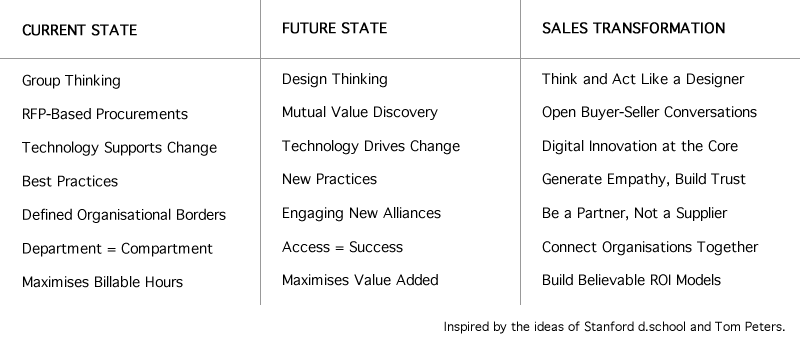
Design Thinking Applied
As illustrated above, knowledge-intensive tech, manufacturing and services firms all suffer from persistent commoditisation, disintermediation or other pressures. These firms must continuously embrace new ways of thinking and working, and this says that Sales Enablement also means Sales Transformation.
As with human change in any organisation, this means that sales professionals must genuinely want to embrace different ways of working. This requires recognition by sales teams and individuals that such practices or techniques are a good thing - from both a self-interest and from a selfless, organisational (and crucially, customer) point of view.
Let's explore a key point exampled in the infographic above, in moving from Current State to Future State, and explore why this Sales Transformations is both worthwhile and necessary:
Moving from RFP-Based Procurements to Mutual Value Discovery
Firstly, lets consider why RFP-Based Procurements should be avoided wherever possible (accepting that in regulated environments, such as government, they are not always entirely avoidable). If you provide a high-value solution, you will inherently offer innovation within such an offering, and despite the fact that buyer's can research much without the intervention of a seller, it makes no sense to expect a buyer to specify - from afar - the exact link between the problem in hand, and the solution required. If a problem-solution may be readily translated then it's not a high-value, high-touch sell that is required. The move to Mutual Value Discovery* means the buyer and seller engaging proactively, and openly in truly understanding the problem and solution required.
RFP-Based Procurements lead to win-lose outcomes. Mutual Value Discovery leads to win-win outcomes between buyer and seller. What underpins this Sales Transformation is Design Thinking.
Note* There is nothing new in the principles behind Mutual Value Discovery and pursuit of a win-win outcome between buyer and seller. See the work by Mary Parker Follett on Integrative Unity, published in 1925.
Design Thinking simply means a state of mind and applying pragmatic method for solving problems in a people-oriented way: Design Thinking in Sales. It is the antithesis of Group Thinking (or groupthink, as it's sometimes called), where everyone in an organisation adopts a highly conformist, uniform way to approach all aspects of work - including buyer-seller interactions.
Here we are placing the buyer at the centre of our approach. It means being focused on the first and most important step in the five steps that characterise Design Thinking in Sales**: Empathize. This is then followed by Define, Ideate, Prototype, and Test - in iterative loops, as illustrated in the infographic below. Directionally, this means each iterative loop passes through the PiercePoint, ProofPoint and DecisionPoint phases of the buying and selling cycle.
Note** Inspired by the Hasso Plattner Institute of Design at Stanford University (d.school).
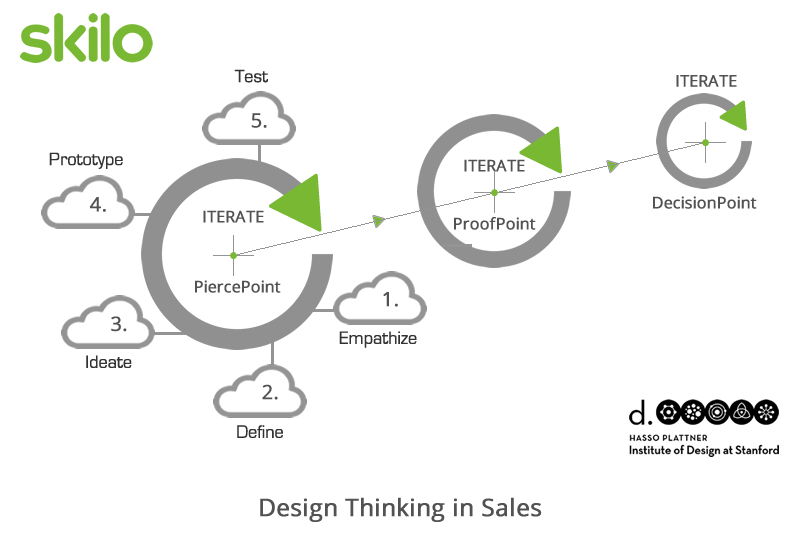
Let's define each of these three phases of iterative Design Thinking in Sales:
#1. PiercePoint
Creating a compelling message that resonates with an empowered, but hard-to-reach decision-maker. This is simply a focus on effective lead generation from a cold start: make the Value Proposition stand out in words and pictures.
#2. ProofPoint
Having aroused the interest of an empowered decision-maker with a PiercePoint message, the ProofPoint becomes the validation of claims made. This is where Mutual Value Discovery and Interactive Decisioning Tools come into play.
#3. DecisionPoint
When engaging a buyer in Mutual Value Discovery workshops, with meaningful Interactive Decisioning Tools, the seller achieves sufficient rapport, receptivity and trust to understand the path, people and politics towards a timely win.
Whilst the PiercePoint message is all about creating communications that resonate with hard-to-reach, empowered buyers, the ProofPoint validation of such as message must be built on a solid foundation of buyer-seller interactions and conversations. This is where a Mutual Value Discovery and a set of Interactive Decisioning Tools become key to ultimate success: winning timely business at the DecisionPoint.
Underpinning each phase here are the five steps of Design Thinking, where validation and re-validation become key to determining how many iterative loops are necessary at each directional phase. What is key here is 'hard coding' such principles and practices in everyday software tools used by sales professionals - e.g. Salesforce Sales Cloud.
Sales Technology Applied
If you have Salesforce Sales Cloud implemented for your high-value, high-touch sales and business development organisation then you have a great foundation for Sales Enablement. As illustrated in the infographic below, this is based on a 'triangulation' of three complementary technologies:
- Salesforce Sales Cloud. Delivering a customisable solution for managing contacts, accounts and opportunities from anywhere, on any device.
- Skilo. Providing a Talent Management extension to Salesforce Sales Cloud, focused on enabling a continuous increase in sales effectiveness for all team members.
- Custom Apps. Creating tailored Software-as-a-Service (SaaS) apps on Salesforce Lightning Platform - the same technology running Salesforce Sales Cloud and Skilo.
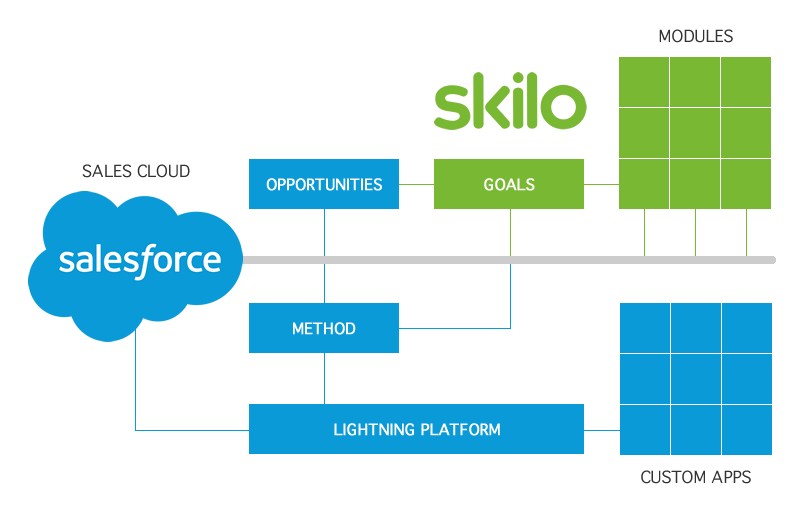
For the high-value, high-touch sell, Sales Enablement is most powerful when the right practices are tangibly linked to Goals and Competencies - and in turn, all measured in relation to real world Opportunities. As a comprehensive Talent Management app, Skilo provides 'cross-Object' integration with any Salesforce Sales Cloud Standard Object or Custom Object - e.g. linking individual team member Goals and Competencies to specific Opportunities.
Since Salesforce Lightning Platform is the common business logic underlying both Salesforce Sales Cloud and Skilo, it also enables the rapid design and publishing of Custom Apps to further enhance sales effectiveness. For example, a tailored (sales) Method or Compensation module (Object) can increase the alignment between Goals and Performance Pay.
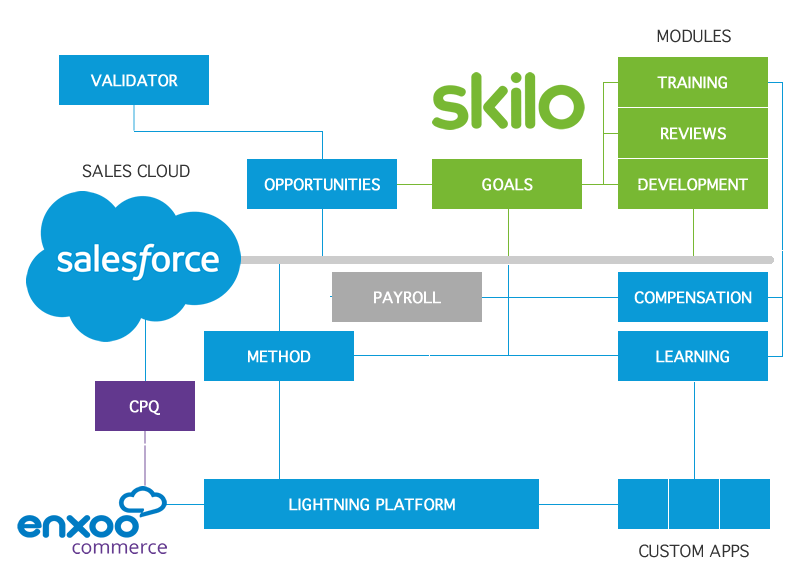
In the infographic above is an example of how 'triangulation' between Salesforce Sales Cloud, Skilo and Custom Apps (built on Salesforce Lightning Platform) can deliver measurable improvements for Sales Enablement. In this example, the Skilo Modules of Goals, Development, Reviews and Training link directly to new Custom Objects created and published on Salesforce Lightning Platform: e.g. Learning; Method; Compensation; and, Validator.
This infographic also shows how other Packaged Apps, such as enxoo Commerce for 'Configure, Price, Quote (CPQ)' automation can further enhance sales effectiveness for say, a communications service provider.
The Sales Enablement outcome in this example above is reliable Sales Forecasting and the ability to defend value over price and counter deal slippage. This is achieved by building a clear Future State versus Current State and Cost of Delay/Cost of Doing Nothing calculations wired into Opportunity Amount and Close Date Field entries. As shown in the infographic above, the Validator (from a Salesforce technology perspective, this is a Community App accessed by Buyers) provides trustful, consistent Sales Forecasting.
Sales Learning Applied
From a Learning and Development perspective, the Skilo Modules for Goals, Development, Reviews and Training may be tailored as the unique Competencies required for different team members and roles, for say, when introducing new practices, such as ROI Modelling.
What matters most here is real-time intervention by coaches and mentors at crucial times in the buying and selling cycle. Sales Enablement cannot be left to passive approaches, hoping that sales people will follow tHe right practices and crucially, ask for help at the right time. The 'triangulation' between Skilo, Salesforce Sales Cloud and Custom Apps (Method, Learning, Compensation, etc.) will enable proactive interventions at crucial stages of the buying and selling cycle.
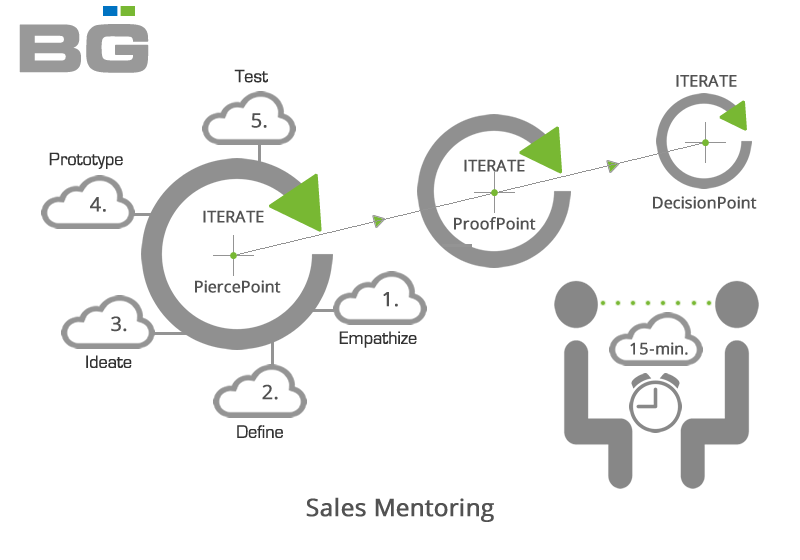
Our unique offering includes Mentoring for your field sales people, integrated with Annual Subscription Fees for the Skilo Talent Management Platform extension to your Salesforce Sales Cloud implementation. This becomes available in 15-minute increments, and delivered as online Google Hangouts or Skype calls in one-to-one sessions with your field sales professionals.
As an outside firm, we become the 'devil's advocate' at the crucial times in your sales team's buying and selling cycles, where reflection or even challenging assumptions and offering insights can prove invaluable to each sales professional. Thereby, it becomes Sales Learning Applied.
Summary
The inherent advantage of Skilo as the Talent Management Platform of choice is clearly evident in applying Sales Enablement, and extending the Salesforce Sales Cloud at companies such as Honeywell and Johnson & Johnson. This means enabling the 'triangulation' between Salesforce Sales Cloud, Skilo and Custom Apps.
What results is Sales Transformation, where Sales Enablement means embracing change and openness, through applying Design Thinking in Sales - underpinned by 15-minutes Sales Mentoring sessions and a focus on continuous improvement, as captured in Salesforce Sales Cloud and the Skilo Talent Management Platform extension.